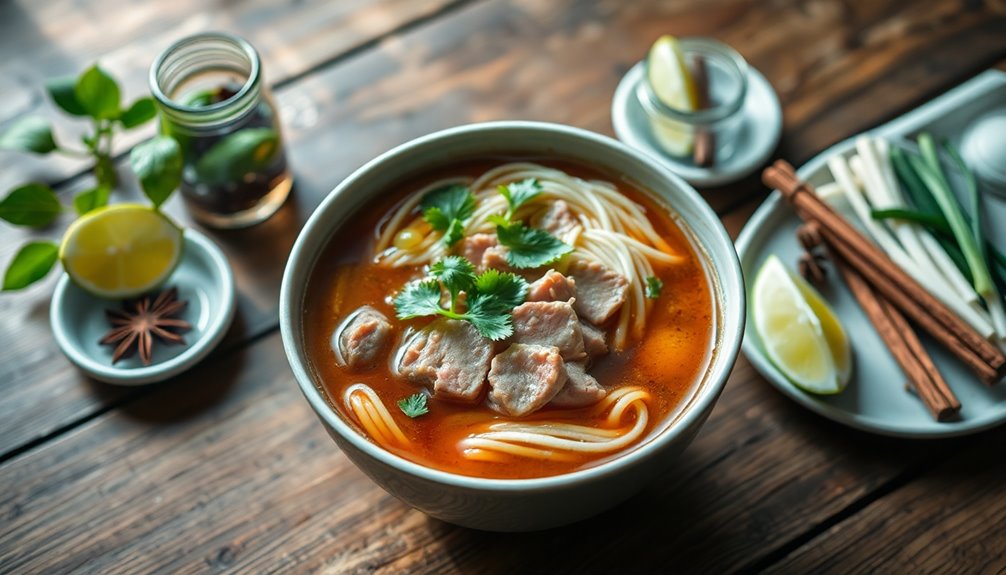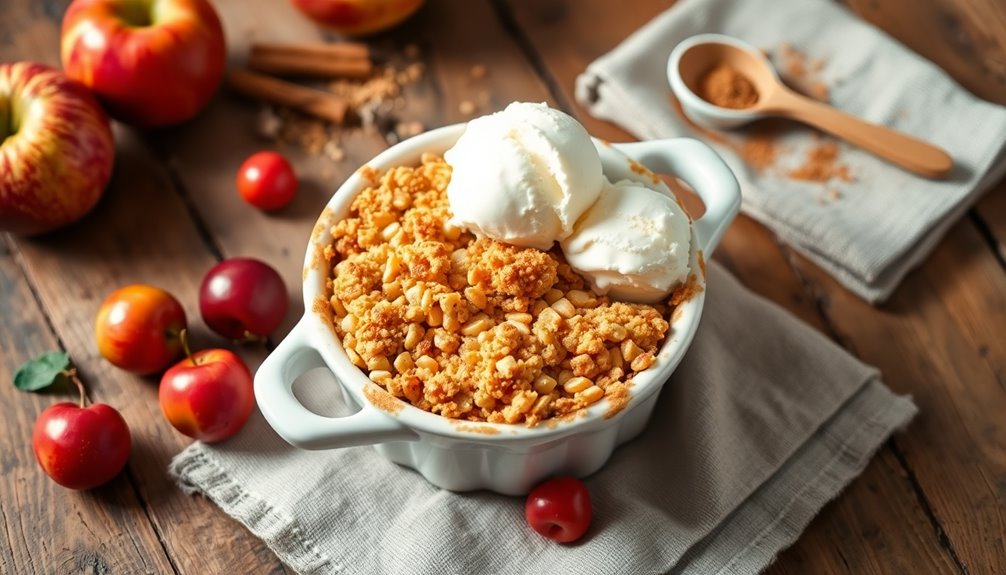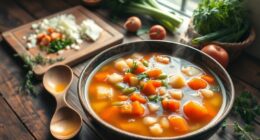To make delicious homemade pho, start by roasting 2 lbs of beef bones or chicken bones for added flavor. Simmer them with a charred onion, ginger, star anise, cloves, and cinnamon in a large pot for 6 hours to create a rich broth. Cook rice noodles until they're chewy, then place them in bowls and ladle the hot broth over them. Add your choice of proteins and top with fresh herbs like basil, cilantro, and mint. For an extra kick, serve with lime wedges and jalapeños. Keep exploring to discover tips on enhancing your pho experience!
Key Takeaways
- Start by roasting beef or chicken bones, along with onion and ginger, to enhance the broth's flavor.
- Simmer the roasted bones with spices for 6 hours to create a rich, aromatic broth.
- Soak rice noodles in hot water until softened, ensuring they maintain a chewy texture.
- Assemble by placing noodles in bowls, ladling hot broth over, and adding optional proteins and fresh herbs.
- Serve with lime wedges, jalapeños, hoisin sauce, and sriracha for a customizable dining experience.
History
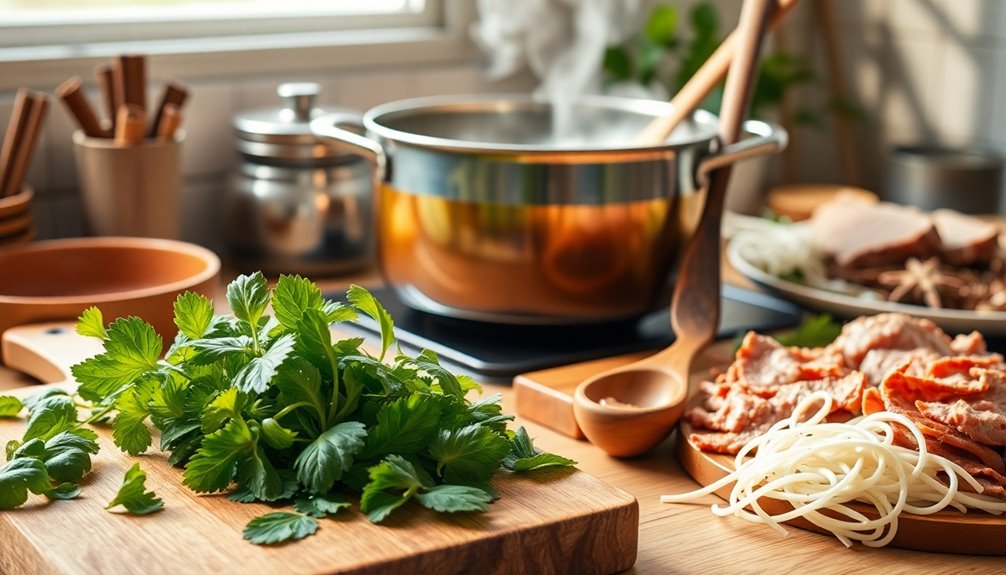
When you plunge into the history of pho, you'll discover a rich tapestry that reflects Vietnam's cultural evolution. This beloved dish emerged in the early 20th century, blending influences from French and Chinese cuisines.
Rice noodles, a local staple, combined with beef or chicken, showcased Vietnam's agricultural bounty. The French colonial period played a significant role, introducing techniques and ingredients that shaped pho into what it's today.
As you explore regional variations, you'll notice how local flavors and ingredients adapt the dish, making it unique across Vietnam. Pho not only satisfies hunger but also symbolizes national identity, resilience, and creativity.
Each bowl tells a story, connecting you to the heart and soul of Vietnamese culture.
Recipe
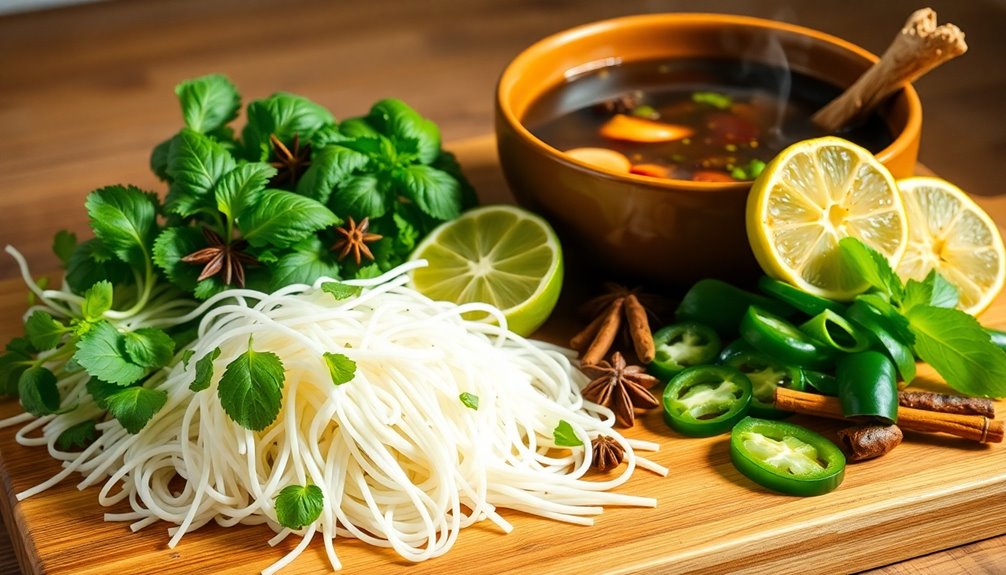
Pho is a traditional Vietnamese noodle soup that has gained worldwide popularity for its aromatic broth and diverse flavors. This dish typically features a savory broth, flat rice noodles, herbs, and meat, usually beef or chicken. The beauty of pho lies in its ability to be customized according to personal taste preferences, making it a beloved meal for many.
To begin making pho, it's crucial to prepare the broth, which is the heart of the dish. A well-made broth can take several hours to develop its rich flavor, but the effort is well worth it. The combination of spices such as star anise, cloves, and cinnamon creates a fragrant base that infuses the noodles and meat with warmth and depth.
Once the broth is ready, it's simply a matter of assembling the ingredients and garnishing with fresh herbs and condiments.
Ingredients:
- 2 pounds beef bones (or chicken bones for chicken pho)
- 1 onion, halved
- 1 ginger root, halved and charred
- 3-4 star anise
- 1-2 cloves
- 1 cinnamon stick
- 1 tablespoon coriander seeds
- 5-6 cups water
- 1 tablespoon fish sauce
- 1 tablespoon sugar
- 8 ounces rice noodles
- Fresh herbs (basil, cilantro, mint)
- Lime wedges
- Sliced jalapeños
- Bean sprouts
- Sliced beef or chicken (if desired)
To prepare the pho, start by roasting the beef bones in a preheated oven at 400°F (200°C) for about 30 minutes until they're browned. In a large pot, combine the roasted bones, charred onion, ginger, star anise, cloves, cinnamon stick, coriander seeds, water, fish sauce, and sugar.
Bring this mixture to a boil, then reduce the heat and let it simmer for at least 6 hours for the best flavor (or 1-2 hours for a quicker option). Strain the broth and return it to the pot. In a separate pot, cook the rice noodles according to package instructions, then drain and rinse.
To serve, place the noodles in a bowl, pour the hot broth over them, and top with sliced meat, fresh herbs, lime, jalapeños, and bean sprouts.
When cooking pho, it's important to take your time with the broth to extract all the flavors from the bones and spices. If you're short on time, consider using a pressure cooker to speed up the broth-making process.
Additionally, feel free to experiment with the toppings and spices to find your ideal flavor profile. Pho is best enjoyed fresh, so prepare the garnishes and noodles just before serving to maintain their texture and vibrancy. Enjoy your homemade pho!
Cooking Steps
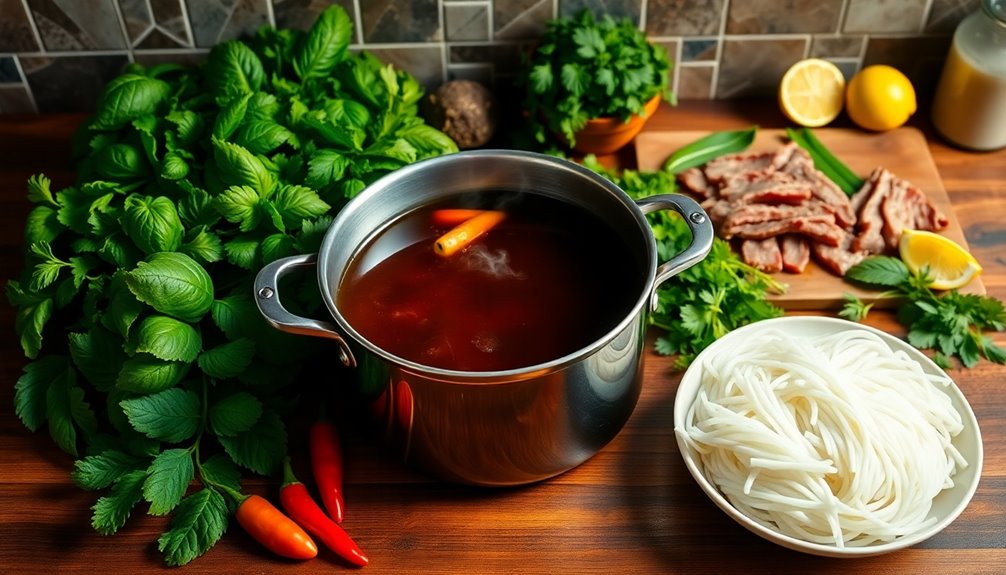
Now that you've gathered all your ingredients, it's time to focus on the cooking steps.
Start by preparing the broth and adding your spices for that authentic flavor.
Once everything's simmering, you'll be just moments away from enjoying a delicious bowl of pho!
Step 1. Prepare Broth Ingredients
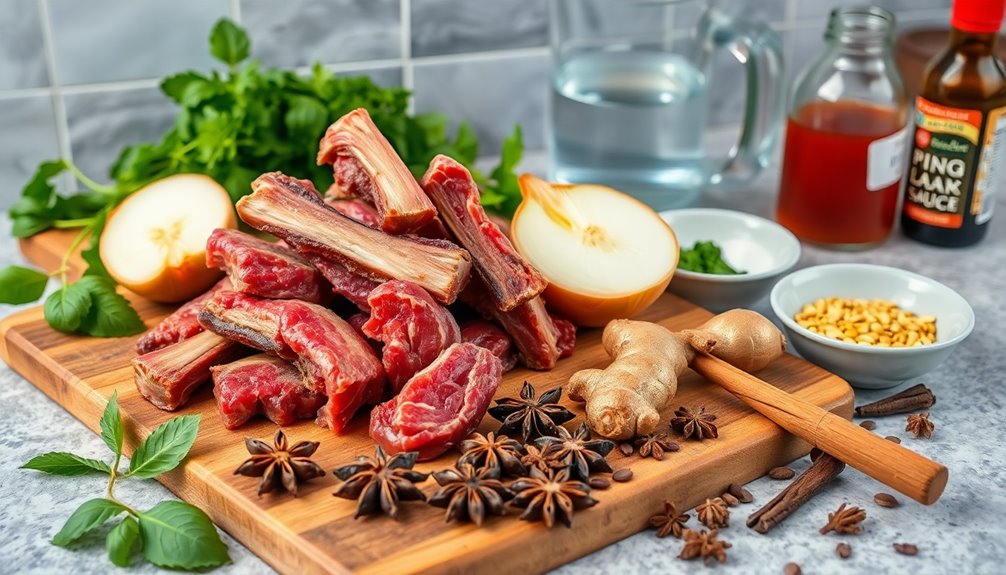
To create a rich and flavorful broth for your pho, gather essential ingredients like beef bones, charred onion, and spices.
Start with about 3-4 pounds of beef bones, preferably a mix of marrow and knuckle bones. This combination gives your broth depth and richness.
Next, char one large onion and a small piece of ginger on an open flame or under the broiler until they're nicely blackened. This step adds a smoky flavor that enhances the broth.
You'll also need a few stalks of fresh cilantro and some green onions for added freshness.
Finally, don't forget to prepare water—enough to cover all the ingredients by a couple of inches in your pot. You're now ready for the next step!
Step 2. Add Spices to Broth
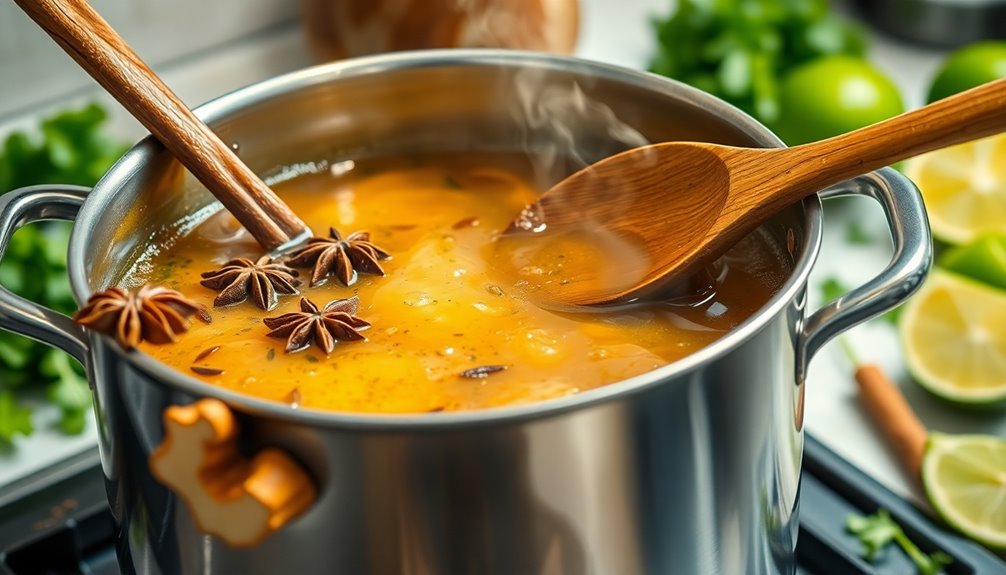
As you prepare to enhance your broth, start by adding the essential spices that will infuse it with authentic flavor.
Begin with star anise, which brings a sweet, licorice-like aroma to your dish. Next, toss in a couple of whole cloves for a warm, aromatic depth.
Don't forget about the cinnamon stick; it adds a subtle warmth that complements the other spices beautifully. You'll also want to include coriander seeds for a citrusy touch and black peppercorns for a bit of heat.
If you like, add a few slices of fresh ginger and a couple of green onions for extra flavor. You can also use fish sauce to deepen the umami, making your broth irresistible.
Mix well to combine.
Step 3. Simmer for One Hour
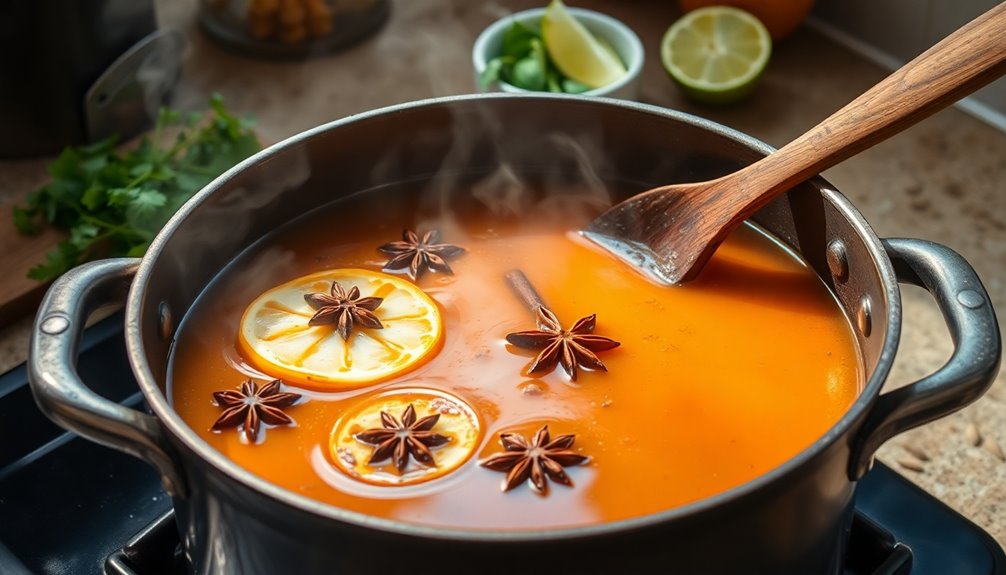
After mixing in those aromatic spices, it's time to let the broth work its magic.
Place the pot on the stove over medium heat and bring it to a gentle boil. Once boiling, reduce the heat to low, allowing it to simmer.
Cover the pot, but leave a small gap for steam to escape. This helps concentrate the flavors while preventing the broth from becoming too cloudy.
Stir occasionally, ensuring the spices and ingredients infuse evenly. You'll notice the delightful aromas filling your kitchen as the broth develops depth.
Keep an eye on the time; an hour is ideal for extracting maximum flavor from the bones and spices. This step is vital for achieving that rich, authentic pho taste.
Step 4. Add Noodles and Toppings
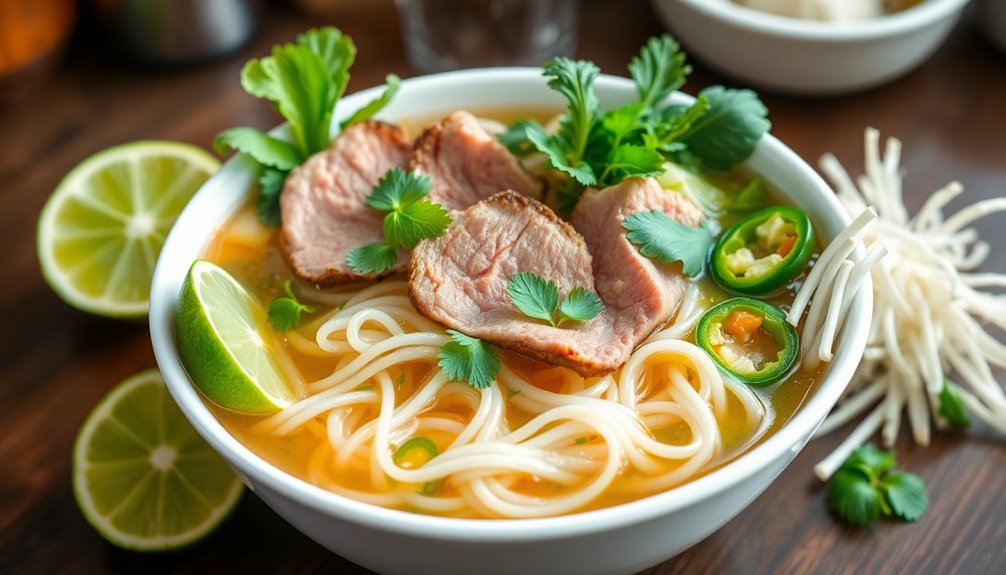
Once the broth has simmered and reached that perfect flavor, it's time to add the noodles and toppings that will complete your pho.
Start by bringing a separate pot of water to a boil. Add your rice noodles and cook them for about 3-5 minutes until they're tender yet firm. Drain the noodles and divide them into serving bowls.
Next, pour the hot broth over the noodles, ensuring you get a good mix of the rich flavors.
Now, it's time to add your chosen toppings—thinly sliced beef, bean sprouts, and green onions are classic options. Don't forget some jalapeños for a kick.
Finally, garnish with a squeeze of lime for that extra zing. Enjoy your delicious creation!
Step 5. Serve With Fresh Herbs

To elevate your pho experience, fresh herbs play an essential role in adding brightness and depth to each bowl. Start by gathering an array of herbs, like basil, cilantro, and mint. These vibrant additions not only enhance flavor but also add a visual appeal to your dish.
When serving, place a generous handful of each herb on the side, allowing everyone to customize their pho according to personal taste. As you enjoy your meal, tear the leaves and stir them into the hot broth; the steam will release their aromatic oils, transforming your soup.
Don't forget to add lime wedges for a zesty kick! With these fresh herbs, your pho will reach new heights of deliciousness. Enjoy each flavorful spoonful!
Final Thoughts
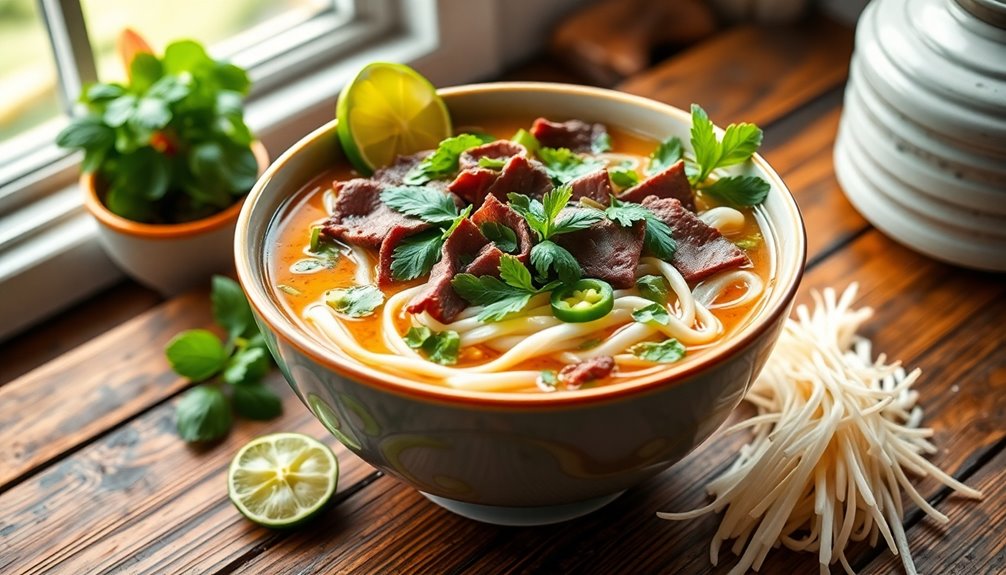
As you wrap up your pho-making adventure, remember that the joy of this dish lies not only in its rich flavors but also in the personal touches you can add.
Experiment with different herbs, spices, and proteins to create a unique bowl that reflects your taste. Don't hesitate to invite friends or family to join in the experience; pho is best enjoyed together.
Make it a tradition to gather around the table and share stories while savoring each flavorful sip.
And if you find yourself with leftovers, pho can be just as delightful the next day.
Frequently Asked Questions
Can I Substitute Beef With Chicken in Pho?
Yes, you can definitely substitute beef with chicken in your dish!
Using chicken will give you a lighter flavor, and it cooks faster, making your meal prep easier.
Just keep in mind that the broth will taste different, so you might want to adjust your seasonings accordingly.
Feel free to experiment with spices and herbs to achieve that delicious depth you love.
Enjoy creating your own twist on this classic recipe!
What Type of Noodles Are Best for Pho?
When you're picking noodles, you'll want to go for rice noodles, specifically banh pho.
These flat noodles come in various widths, and you can choose between wide or thin based on your preference. They soak up flavors beautifully, enhancing your dish.
Cook them until they're just tender, then rinse them under cold water to stop the cooking process. This way, you'll get that perfect texture and taste in your meal!
How Long Can I Store Leftover Pho?
You can store leftover pho in the fridge for about 3 to 4 days.
Just make sure to separate the broth from the noodles and other ingredients to keep everything fresh.
If you want to keep it longer, consider freezing it; it'll last up to 3 months in the freezer.
When you're ready to enjoy it again, simply thaw and reheat, and you'll have a delicious meal waiting for you!
Is Pho Gluten-Free?
Yes, pho can be gluten-free, but it depends on the ingredients you use.
Traditional pho broth is typically gluten-free, made from beef or chicken and spices. However, the rice noodles are usually safe as they're made from rice.
Be cautious with any sauces or seasonings, as some may contain gluten. Always check labels, and if you're dining out, ask the restaurant about their ingredients to guarantee your meal is truly gluten-free.
What Herbs Are Traditionally Used in Pho?
When you explore traditional Vietnamese cuisine, you'll find that fresh herbs play an essential role in enhancing flavors.
In pho, you'll typically use herbs like basil, cilantro, and mint. These herbs not only add aroma but also offer a revitalizing contrast to the rich broth.
You might also encounter green onions and bean sprouts, which contribute texture and freshness.
Incorporating these herbs will elevate your dish and provide an authentic experience.
